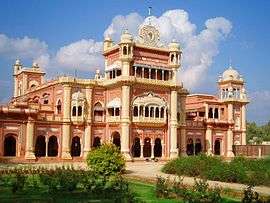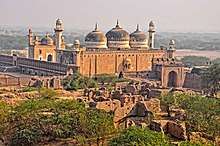Mir (title)
Mir (مير) (which is derived from the Arabic title Emir 'general, prince') is a rare ruler's title in princely states and an aristocratic title generally used to refer to a person who is a descendant of a commander in medieval Muslim tradition.
It was adopted in many languages under Islamic influence, such as Balochi, Ottoman Turkish,[1] Persian, Turkish, Sindhi language, Azerbaijani, Kurdish, Kashmiri language, language and Pashto language meaning leader of a group or tribe. According to the book Persian Inscriptions on Indian Monuments, Mir is most probably an Arabized form of Pir. Pir in Old Persian and Sanskrit means the old, the wise man, the chief and the great leader. Pir is a religious leader' title for Kurdish Alevi and Yarsanism faith meaning old and wise spiritual leader. Amir, meaning "Lord" or "commander-in-chief", is derived from the Arabic root a-m-r, "command".
Title
Ruling princes
In Muslim princely states of British India, few rulers were formally styled Mir, notably in present Pakistan, where only two of the six have actually reached the level of salute state, becoming entitled to a gun salute and the attached form of address His Highness:
- the Mir of Khayrpur (Khairpur) (17 guns), a Rajputana part of present Pakistan's Sindh province, under a branch of the Talpur clan
- the Mir of Hunza (15 guns), senior among the many Pashtun Northwestern Frontier states
The following all remained non-salute states :
- the Mir of Mirpur State, under a branch of the above Talpur clan, in Sind(h)
- the Mir of Kharan; from 1921, restyled Sardar Bahador Nawwab, till 1940 a vassal of the Khan and Wali of Khalat (the senior ruler in British/Pakistani Baluchistan)
- petty Pashtun Northwestern Frontier states
- the Mir of Amb (Tanawal), capital Darband; from 1868, restyled Nawwab; from 1921 promoted Nawwab Bahador
- the Mir of Nagar, in the northern part of Gilgit–Baltistan.
- the Mir of Jandala State, a petty Rajput North Frontier state
Honorary title
Mir was also used as an honor rank. (See: Mirza) In Balochistan, mir is also an honorific title give to The Khan of Kalat and a sardar son or brother. When a mir has twelve mirs under him he becomes a sardar. It is given as well to people in religion. Sayyid sons or brothers remain as such until they fulfill the complete Islam requirement and hold the title of mir instead of sayyid.
The title mir was also used by members of the chief clans of the Soomro and Talpur tribe before and after they became rulers of Sindh. Today, it is still used by their descendants.
Compound titles
On the Indian subcontinent, since the Mughal period, various compounds were used in Urdu including:
- combined Indian princely styles, notably Sahibzada mir
- Mīr-tuzak or tǒzak: Marshal, in the sense of an officer who maintains order in a march or procession; master of the ceremonies
- Mīr-dah or Mīr-daha: Commander or superintendent of ten: decurion; a Tithingman
- Mīr-sāmān: Head steward
- Mīr-shikār: Master of the hunt, chief huntsman; also Grand Falconer; hence bird-catcher, and (metaphorically) a pimp
- Mīr-ě-ātash or Mīr-ātish: Chief of the fireworks; also Commandant of artillery, Master of the ordnance
- Mīr-ě-majlis, shortened Mīr-majlis: Master of the ceremonies or president, chairman of a majlis (assembly)
- Mīr-mahalla: Headman of a mahal(la), i.e. quarter (of a town)
- Mīr-ě-manzil, shortened Mīr-manzil: Overseer of the halting-places; Quartermaster-general
- Mīr-munshī: Chief secretary; Head (native) clerk of a (colonial) office.
In the Hindu kingdom of Nepal:
- Mir Munshi, from the Arabic Amir-i-Munshi, 'commander of the secretaries', is the Chief Secretary of the Foreign Office.
- Mir Umrao, from the Arabic Amir ul-Umara, 'commander of commanders': a senior military officer ranking below a Sardar and charged with the command of a fort and surrounding territories, the training and equipment of soldiers and the supply of material.
In the Baloch kingdom of Balochistan :
- Mir Chakar Rind, Ruler of Balochistan in the 15th Century.
In the Ottoman Empire, mir-i miran was used as the Persian equivalent to the Turkish title beylerbey ("bey of beys"), alongside the Arabic equivalent amir al-umara ("emir of emirs").[1]
See also
- There are several cities and towns in Pakistan named after this very princely title. These include Mirpur, in Kashmir, and Mirpurkhas, in Sindh.
- In the tribal societies of South Asia, many people used this word with or as rather as part of their names e.g. Mir Murtaza Bhutto, as happens with many titles (especially khan), not only those holding a position as tribal or other leader.
- Mir is a prominent family name among people of Kashmiri origin in Punjab province of Pakistan.
- Amir (later Amir Nawwab) of Bahawalpur)
Gallery
 Residency of the Mir Talpur
Residency of the Mir Talpur Mosque dedicated to Abbas ibn Ali in Derawar Fort.
Mosque dedicated to Abbas ibn Ali in Derawar Fort.
References
Sources and external links
- Platt's Dictionary of Urdu&Hindi
- Emir
- RoyalArk - here India
- Royal Ark on princely states- here Pakistan
- Indian princely States un www.uq.net.au (here page Jandala), as archived on web.archive.org
- Pakistan's Northern Areas dilemma
- Northern Areas Development Gateway
- Pakistan's Northern Areas
- Northern Pakistan's Karakoram & Hindukush Mountains
- The Mountain Areas Conservancy Project